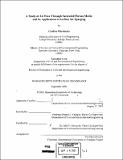A study of air flow through saturated porous media and its applications to in-situ air sparging
Author(s)
Marulanda, Catalina, 1971-
DownloadFull printable version (37.65Mb)
Other Contributors
Massachusetts Institute of Technology. Dept. of Civil and Environmental Engineering.
Advisor
Patricia J. Culligan.
Terms of use
Metadata
Show full item recordAbstract
The efficiency of an in situ air sparging system is controlled by the extent of contact between injected air and contaminated soil and pore fluid. Characterizing the mechanisms governing air propagation through saturated porous media is therefore critical to the design of an effective cleanup treatment. The objectives of this investigation were thus to identify and to quantify the parameters that affect the advancement of an air front through saturated soils. To this end, an experimental program was conducted in order to assess the impact of: 1) operational parameters, specifically the differences in air propagation as a result of injection under constant pressures and constant flow rate conditions, as well as the impact of injector geometry; and 2) medium properties, namely hydraulic conductivity and pore fluid characteristics. Experiments were conducted in a geotechnical centrifuge, which made it possible to test under a wide range of injection pressures while maintaining both realistic fluid and soil pressures, and sample stability. Experimental results show that air propagation characteristics through saturated soils are primarily controlled by two factors, the pressure in the air phase and the hydraulic conductivity of the medium. Under constant pressure injection, the magnitude of the pressure gradient between air and pore fluid dictates the final shape of the air plumes. Under constant flow rate injection, the relationship between the rate of air inflow and of pore fluid outflow determines the volume available for air invasion, and consequently, (cont.) the pressure in the air phase. Both the hydraulic conductivity of the medium and the compressibility of the air are crucial in the determination of the final plume volume. Experimental findings were used in the development of a simplified model of air flow through porous media, which predicts the shape of plumes under constant flow rate injection conditions. The model is based on the premise that since the use of IAS systems is restricted to coarse, granular materials, the magnitude of capillary pressures is negligible relative to that of hydrostatic pressures. Air propagation can therefore be modeled as the advancement of a uniform front driven by an evolving pressure gradient.
Description
Thesis (Ph. D.)--Massachusetts Institute of Technology, Dept. of Civil and Environmental Engineering, 2001. Includes bibliographical references (v. 2, leaves 305-312).
Date issued
2001Department
Massachusetts Institute of Technology. Department of Civil and Environmental EngineeringPublisher
Massachusetts Institute of Technology
Keywords
Civil and Environmental Engineering.